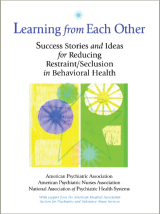In collaboration with consumers, nurses, psychiatrists, and others, NAPHS has developed an array of resources to help members work to reduce the use of restraint and seclusion.
Restraint and seclusion, when used properly, can be life-saving and injury-sparing measures. These emergency measures aim to protect patients in danger of harming themselves or others and to enable patients to continue treatment successfully and effectively. Because hospitals and other treatment settings serve individuals with severe mental illnesses and substance abuse problems who are, at times, dangerous to themselves or others, they must have strategies and policies in place for determining why, when, and how these measures will be used.
These are, however, measures that also have potential for injury — both of patients and of staff. They also have the potential for abuse, if used improperly.
The challenge is to find a balance that ensures safety while maintaining patients’ dignity and avoids inappropriate use of restraint/seclusion.
6/16/2016 | CMS proposed rule: "Medicare & Medicaid: Hospital & Critical Access Hospital Changes to Promote Innovation, Flexibility, and Improvement in Patient Care" (proposed changes to Hospital CoPs) |
1/13/2012 | CMS notice (CMS-R-306): Reinstatement without change of a previously approved collection: "Condition of Participation--Use of Restraint/Seclusion in Psychiatric Residential Treatment Facilities Providing Psychiatric Services to Individuals Under Age 21 & Supporting Regulations at 42CFR 483.350-483.376" [View] |
12/8/2006 | CMS final rule on "Medicare and Medicaid: Hospital participation conditions; patients' rights" [CMS-3018-F] published in the Federal Register. Includes revised regulatory language on the "one-hour rule." |

